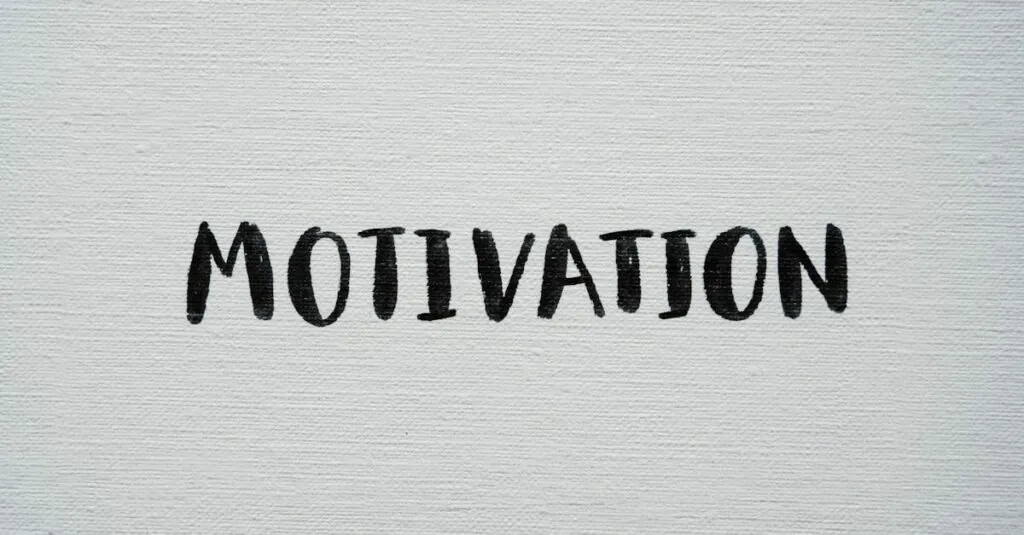Ever wonder what really gets people moving? It’s not just that second cup of coffee or the promise of pizza at the end of a long workday. Enter the drive theory of motivation, a fascinating concept that explains why we pursue certain goals with the intensity of a cat chasing a laser pointer. This theory suggests that our behaviors are driven by basic biological needs, like hunger and thirst, which can spark a fire under even the laziest of couch potatoes.
Table of Contents
ToggleOverview of Drive Theory of Motivation
Drive theory of motivation explains that human behavior often arises from biological needs. Hunger and thirst serve as primary motivators, prompting individuals to act to satisfy these demands. Each need creates a drive that compels action, fostering goal pursuit.
Physiological needs rank highest in the hierarchy of motivation. When individuals experience hunger, their energy focuses on securing food. Similarly, thirst leads people to seek water and restore balance.
The theory suggests behaviors arise as responses to unmet needs. A person lacking social interaction may seek companionship to fulfill the need for belonging. Activities often align with these biological imperatives, influencing choices and direction.
Drive theory emphasizes intrinsic motivation over extrinsic incentives. While external rewards, like praise or bonuses, can influence behavior, satisfying innate needs tends to have stronger effects. People may engage in activities for pleasure or personal satisfaction, driven by internal motivations.
This framework can apply to various contexts, including education and workplace environments. Understanding how established drives correlate with motivation can inform strategies to enhance performance and engagement. Reinforcing motivation by addressing basic needs often leads to more sustainable outcomes in personal and professional settings.
Drive theory remains vital in understanding human behavior. It sheds light on why individuals make certain choices and how these choices align with their fundamental needs. By acknowledging biological needs, one can better grasp the underlying motivations that drive actions and decisions.
Historical Background
The drive theory of motivation has roots in biological and psychological research. Pioneering work by several theorists laid a foundation for understanding how intrinsic drives influence behavior.
Key Theorists
Clark Hull significantly contributed to the development of drive theory. His work in the 1940s framed motivation as a function of physiological needs requiring satisfaction. Hull posited that drives create states of tension leading to goal-oriented behavior. Another influential figure, Abraham Maslow, introduced a hierarchy of needs, elevating understanding of how basic requirements motivate actions. While Hull focused on immediate drives, Maslow emphasized the importance of fulfilling higher-order needs for self-actualization.
Evolution of the Theory
In subsequent years, researchers expanded the drive theory. A focus on additional psychological factors enhanced the original concepts. In the 1980s, Edward Deci and Richard Ryan introduced self-determination theory, exploring how autonomy and competence relate to motivation. This shift underscored the importance of intrinsic motivation alongside basic biological drives. Ongoing studies have integrated various approaches, solidifying the drive theory’s place in contemporary psychology. Scholars continually investigate how biological and social factors interplay to shape human behavior.
Core Concepts of Drive Theory
Drive theory centers around the idea that human behavior stems from biological needs. These needs act as powerful motivators, influencing actions to reach desired states of fulfillment.
Definition of Drives
Drives represent internal states triggered by physiological imbalances. An example includes hunger, which arises when the body requires nourishment. Such imbalances generate a sense of tension, pushing individuals to engage in behavior to restore equilibrium. Drive theory categorizes these internal states as essential for survival, linking them closely to actions aimed at alleviating discomfort. The emphasis on drives highlights their role in shaping human motivation and behavior in various contexts.
Types of Drives
Drives fall into two primary categories: primary and secondary drives. Primary drives, such as hunger and thirst, emerge directly from biological needs vital for survival. Secondary drives, including those related to social connections, develop through experience and learning. Each type of drive influences behavior differently, with primary drives triggering immediate responses to fulfill essential needs. By contrast, secondary drives reflect more complex motivations that arise from environmental interactions and personal aspirations. Understanding these categories reinforces the significance of different motivations in shaping human behavior and decision-making processes.
Applications of Drive Theory
Drive theory has broad applications across various fields, particularly in psychology, education, and workplace motivation. These contexts benefit from understanding human motivation rooted in basic biological needs.
In Psychology
Drive theory serves as a foundational concept in psychology, explaining how innate drives influence behavior. Clark Hull’s research highlights physiological needs as core motivators. Hunger and thirst create a state of tension, pushing individuals to seek food and water. This perspective aids psychologists in analyzing actions based on biological demands. Intrinsic motivation emerges as a key focus. When psychological needs, like social belonging, remain unmet, individuals exhibit behaviors aimed at fulfilling these needs. Observing these dynamics helps professionals devise effective interventions for behavioral issues.
In Education
Drive theory’s principles enhance educational approaches by addressing students’ motivational needs. Educators can create environments that satisfy basic needs, fostering engagement. For instance, hunger, a primary driver, affects students’ ability to concentrate. Providing proper nutrition supports learning. Additionally, intrinsic motivation plays a significant role in student success. Encouraging autonomy and competence leads to higher academic performance. By aligning teaching methods with students’ drives, educators can cultivate a more effective learning atmosphere. Focusing on these elements not only boosts performance but also encourages lifelong learning.
In Workplace Motivation
Drive theory significantly impacts workplace motivation by linking employees’ performance to their intrinsic and extrinsic needs. Employers who recognize the importance of satisfying basic needs tend to see improved employee engagement. For example, creating a supportive work environment addresses workers’ psychological needs. When employees feel a sense of belonging, their productivity increases. Additionally, fostering opportunities for autonomy empowers individuals to take initiative. Drive theory emphasizes the relationship between motivation and satisfaction. By implementing strategies that fulfill various drives, organizations can enhance overall performance and job satisfaction.
Critiques of Drive Theory
Drive theory faces several critiques that highlight its limitations in explaining human motivation comprehensively.
Limitations
Behavior isn’t solely driven by biological needs as drive theory suggests. Many external factors, like social influences and environmental cues, play a significant role in shaping actions. Humans often pursue goals driven by long-term aspirations rather than immediate physiological needs. Additionally, the theory doesn’t adequately account for complex emotions and cognitive processes that influence behavior. Critics point out that it oversimplifies motivation by focusing primarily on basic drives, ignoring cultural factors and individual differences that affect people’s decisions. The lack of empirical support for some of its claims further raises questions about its applicability to diverse populations.
Alternative Theories
Several alternative theories emerge to address the shortcomings of drive theory. Self-Determination Theory emphasizes the importance of autonomy, competence, and relatedness in motivating behavior. This perspective shifts focus from just biological needs to including psychological well-being. Another notable framework is the Expectancy-Value Theory, which posits that individuals’ motivation stems from expectations of success and the value placed on the outcome. Behavioral theories, such as operant conditioning, also provide insight into how rewards and punishments shape motivation. These approaches highlight a broader view of motivation, integrating internal drives with external incentives and social contexts.
Drive theory of motivation offers valuable insights into the fundamental forces that drive human behavior. By emphasizing the role of biological needs like hunger and thirst, it reveals how these intrinsic drives can shape actions and decisions. While the theory has its limitations and faces critiques regarding its scope, its applications in psychology, education, and workplace settings remain significant.
Understanding these core motivations can lead to improved engagement and satisfaction in various environments. As researchers continue to explore the complexities of human motivation, integrating drive theory with alternative perspectives can enhance our grasp of what truly inspires individuals. Ultimately, recognizing the interplay between biological needs and psychological factors can foster a more comprehensive understanding of motivation in everyday life.





